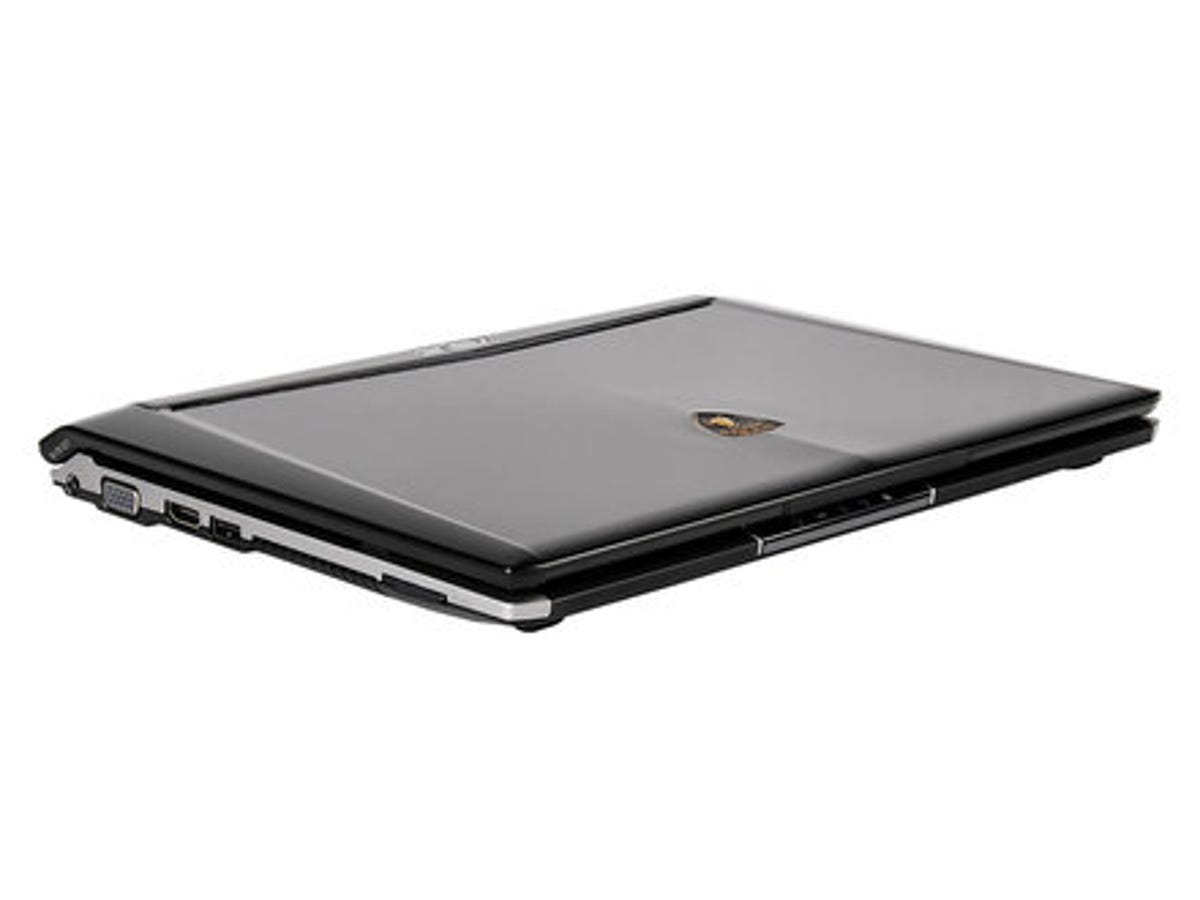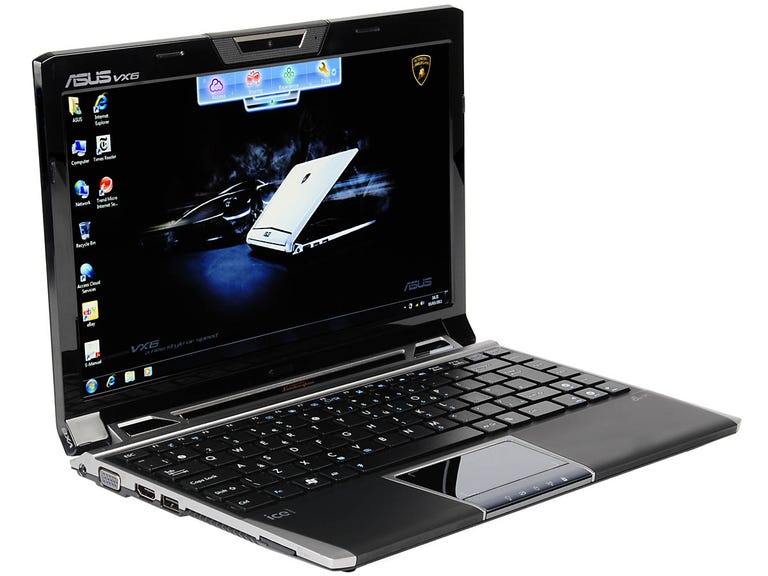 Why You Can Trust CNET
Why You Can Trust CNET Asus Eee PC Lamborghini VX6 review: Asus Eee PC Lamborghini VX6
The Asus Eee PC Lamborghini VX6 might resemble its supercar namesake, but sadly it's not got as much oomph. It's faster than most netbooks, but as it costs as much as a normal laptop, it's hard to recommend splashing out.
We're no strangers to fast cars here at CNET UK, and we're certainly well acquainted with netbooks. We're even on speaking terms with the odd mutant hybrid of the two, and yet despite being pretty familiar with all of the above, the 12.1-inch Asus Eee PC Lamborghini VX6 netbook is still causing our collective eyebrows to rocket upwards.
The Good
The Bad
The Bottom Line
It's an oddly shaped, car-themed netbook that'll set you back around £510, so strap in and let's take this weird little portable PC for a spin.
Automobilophilia
The design on offer here is pretty radical, and we can't tell if it looks cool and futuristic, or just plain hideous. The lid features a prominent Lamborghini badge that, while well made, will instantly single you out as the kind of person who buys things that carry car branding but crucially are not actual cars.
There's a jet-black gloss finish and a grille along the base of the lid, as well as an angular moulded shape on the top of the netbook that makes it look a bit like a car bonnet, which we'd guess is the idea.
The same styling extends to the interior, where pointy bits of chrome, angry-looking silvered edges and sloping wrist rests dominate. We'd suggest eyeing up the pictures above to get the full idea, but suffice to say it's a fairly striking look.

The tapered trackpad and mirrored space above the keyboard will draw attention, and obsessives will be infuriated that the glowing white LED that marks the power switch on the right isn't replicated on the chrome patch symmetrically opposite. All in all, it's pretty mental.
We don't hate the design, though we wish we could take a screwdriver to the crass Lambo-logo on the lid. We think many people would prefer a sleeker, cleaner, more traditional netbook than this, especially if you're ever going to give a presentation or make a speech, and need to be taken even just a little bit seriously.
One final touch for Lamborghini-lovers is a loud revving noise when the laptop starts up. It's daft, but we have to admit it made us smile.
Just like a real Lamborghini, you'll struggle to fit this netbook into a small bag. Indeed, for something that falls into the netbook category, this is a rather un-portable machine. it measures 204 by 297 by 29mm, and weighs 1.5kg, making it bigger and heavier than most netbooks. The battery pack juts out at the bottom, which means the VX6's keyboard slopes slightly toward you (helpful) but also makes the whole netbook quite chunky (less helpful).
Key to ignition
The advantage of having a slightly larger chassis than most netbooks opt for is that you can fit in all sorts of neat bits and pieces. The keyboard for example is impressively spacious, so typing is comfortable. The trackpad is quite large too, and even though the click buttons are quite stiff, the mirror-finished sensitive surface feels pleasantly responsive.
The 12.1-inch display has a resolution of 1,366x768 pixels, which is
higher than most netbooks. It's clear and bright, though we noticed the
viewing angle isn't great -- tilting the screen even just a little will
make the on-screen colours turn rather weird.
There's a healthy port selection here as well. Three USB ports, one of which is USB 3.0, Ethernet, 3.5mm sockets for headphones and a mic, a multi-format card reader, and VGA and HDMI outputs complete the setup. There's a webcam above the display too, and a 250GB hard drive nestled among the VX6's insides. Also note that the whole lot runs on Windows 7 Home Premium 32-bit.
Interestingly, the power supply jack that plugs into the netbook and keeps it juiced is incredibly tiny -- that's good for portability, but if you happen to lose the power cable, you might have a hard time replacing it.
Pedal to the metal
This netbook costs about £200 more than most, so you'll excuse us if we expect something a little special in the performance department. This micro machine is running on an Intel Atom D525 CPU clocked at 1.8GHz, backed up by 2GB of RAM and an Nvidia Ion graphics unit.
Now, to be honest, the Intel Atom chip isn't going to deliver a huge amount of computational grunt (even if it is dual-core), and while 2GB is better than the 1GB we see on many netbooks, it's still not a huge amount of memory. The graphics card, however, is more interesting, as that's unusual to see on a netbook.
Sadly though, this minuscule motorhead didn't manage performance too far out of the ordinary in our testing. There's a dedicated button at the top left of the keyboard that lets you quickly cycle through power modes, and we put the VX6 in turbo mode to run our benchmark tests. The netbook managed a score of 2,242 in our PCMark05 test, and 2,704 in our 3DMark06 test.
That's better performance than we'd expect from a netbook, especially in the graphics department, but it's not all that impressive, to be honest. Practically speaking, while ordinary multi-tasking will feel nice and fluid, you won't really be able to do many extra things with that hardware. We suspect gaming will be out of the question unless you're playing quite old games, and both our 1080p test footage and YouTube HD streaming played with some irritating stuttering.
Battery life is quite impressive -- we ran our Battery Eater benchmark, which guns a laptop's CPU at a constant 100 per cent and times how long it takes for the battery to drain. It sounds cruel, and it is, but it's a cold necessity. The VX6 managed 3 hours and 58 minutes in power-saving mode, so expect that battery life as a minimum. That's impressive, especially for a larger netbook with a graphics card.
That said, your options are slim if you want something netbook-sized that offers similar performance for around the same price. Either forsake performance and go with a smaller netbook (and save some money in the process) or get more computational grunt from a 'proper' laptop and sacrifice portability.
Conclusion
Although it's hardly understated, we don't mind the design, apart from the ostentatious Lambo badge on the lid. The large keyboard and trackpad make this PC comfy to use.
It falls between two stools, however -- too expensive when there are so many cheaper netbooks, but also not powerful enough to compete with full-sized laptops. If you like the design, this is a cool piece of kit, otherwise you're better off compromising with either a netbook or a full-sized laptop.
There is one machine that sits roughly alongside the VX6 -- the Acer Ferrari One, a netbook we reviewed in 2009 that also sports better-than-most performance. If you have a few more hundreds of pounds to spare, Alienware's M11x has an 11-inch screen but is otherwise a fully functional games machine.
Edited by Nick Hide


